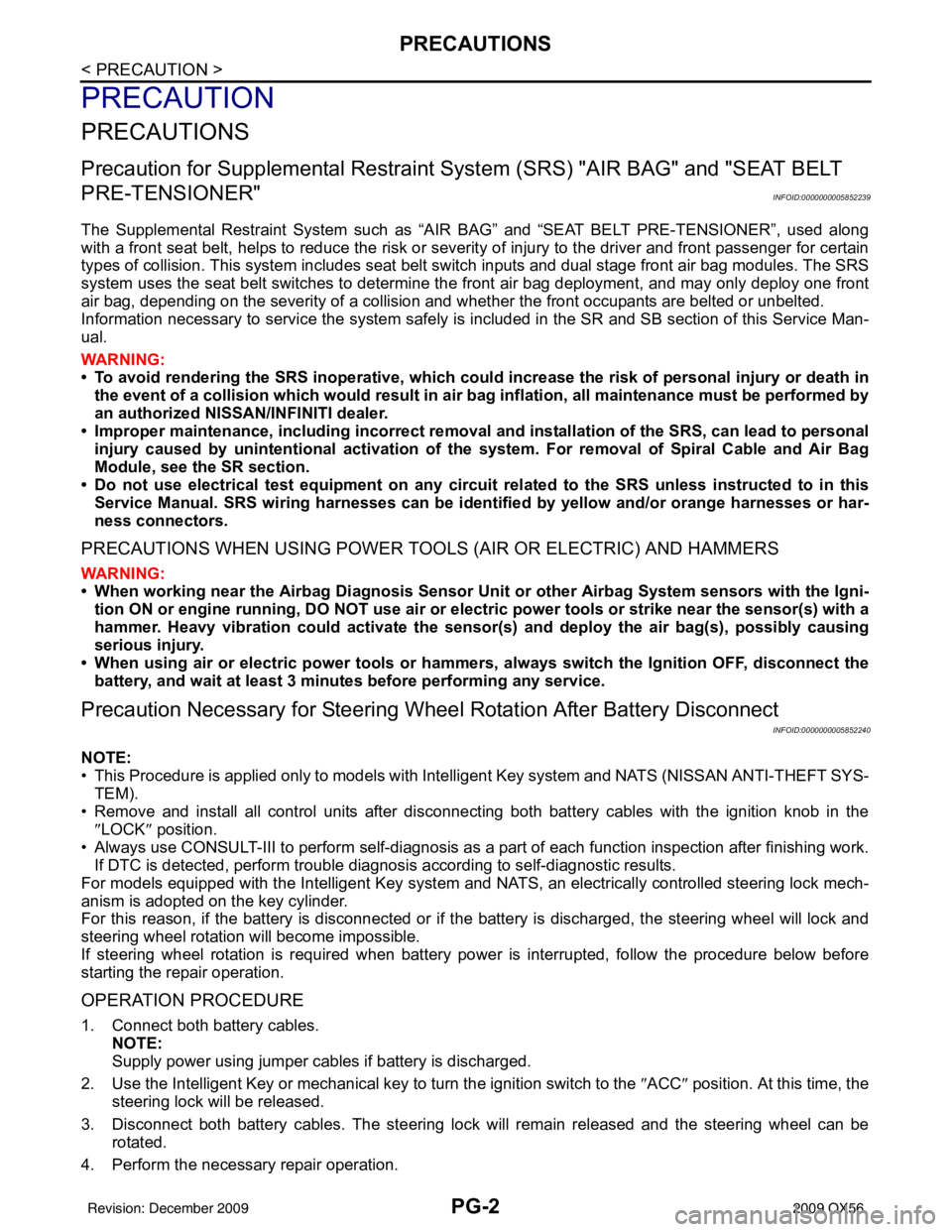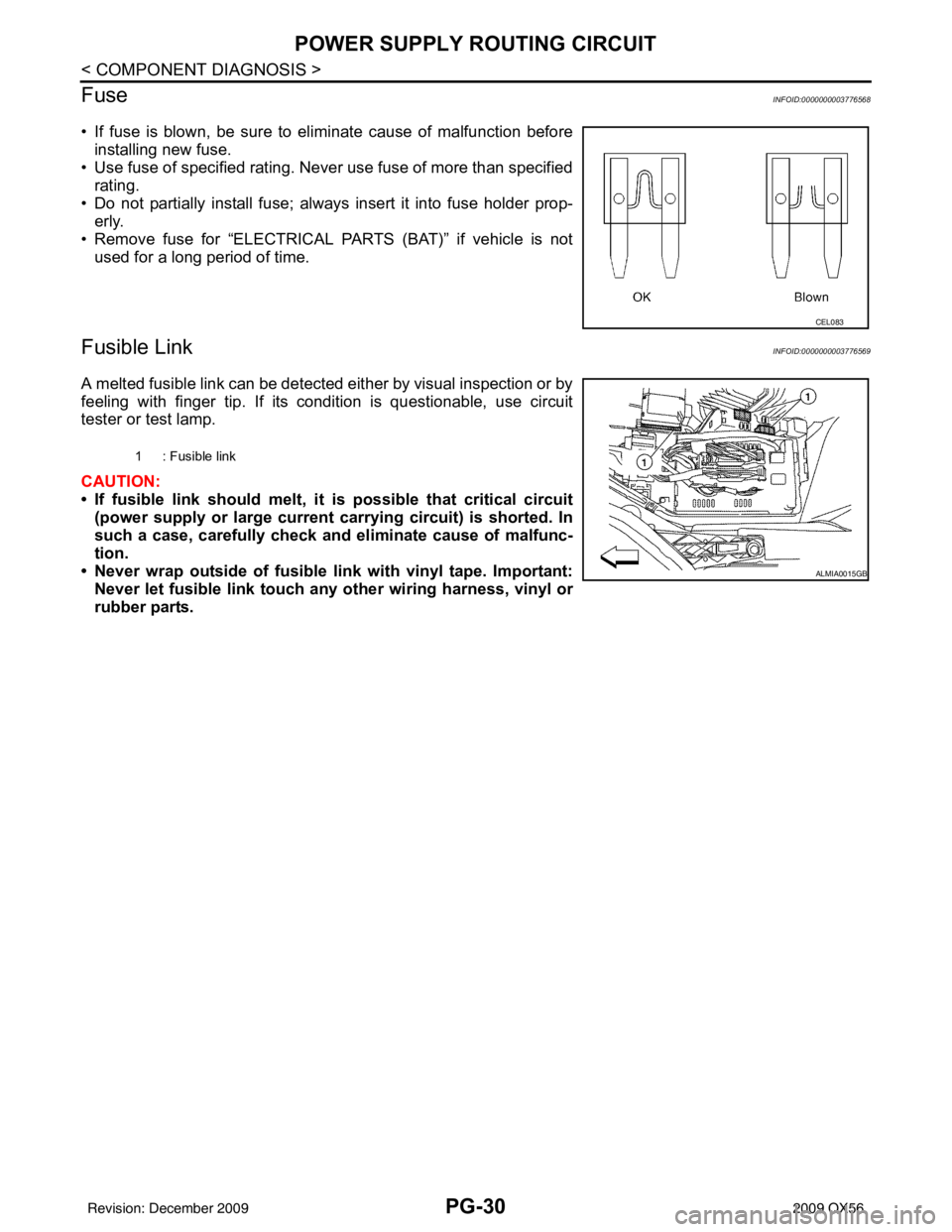2009 INFINITI QX56 electric
[x] Cancel search: electricPage 2869 of 4171
![INFINITI QX56 2009 Factory Service Manual PCS-32
< PRECAUTION >[IPDM E/R]
PRECAUTIONS
PRECAUTION
PRECAUTIONS
Precaution for Supplemental Restraint Syst
em (SRS) "AIR BAG" and "SEAT BELT
PRE-TENSIONER"
INFOID:0000000005851897
The Supplemental INFINITI QX56 2009 Factory Service Manual PCS-32
< PRECAUTION >[IPDM E/R]
PRECAUTIONS
PRECAUTION
PRECAUTIONS
Precaution for Supplemental Restraint Syst
em (SRS) "AIR BAG" and "SEAT BELT
PRE-TENSIONER"
INFOID:0000000005851897
The Supplemental](/manual-img/42/57031/w960_57031-2868.png)
PCS-32
< PRECAUTION >[IPDM E/R]
PRECAUTIONS
PRECAUTION
PRECAUTIONS
Precaution for Supplemental Restraint Syst
em (SRS) "AIR BAG" and "SEAT BELT
PRE-TENSIONER"
INFOID:0000000005851897
The Supplemental Restraint System such as “A IR BAG” and “SEAT BELT PRE-TENSIONER”, used along
with a front seat belt, helps to reduce the risk or severity of injury to the driver and front passenger for certain
types of collision. This system includes seat belt switch inputs and dual stage front air bag modules. The SRS
system uses the seat belt switches to determine the front air bag deployment, and may only deploy one front
air bag, depending on the severity of a collision and w hether the front occupants are belted or unbelted.
Information necessary to service the system safely is included in the SR and SB section of this Service Man-
ual.
WARNING:
• To avoid rendering the SRS inopera tive, which could increase the risk of personal injury or death in
the event of a collision which would result in air bag inflation, all maintenance must be performed by
an authorized NISSAN/INFINITI dealer.
• Improper maintenance, including in correct removal and installation of the SRS, can lead to personal
injury caused by unintent ional activation of the system. For re moval of Spiral Cable and Air Bag
Module, see the SR section.
• Do not use electrical test equipmen t on any circuit related to the SRS unless instructed to in this
Service Manual. SRS wiring harn esses can be identified by yellow and/or orange harnesses or har-
ness connectors.
PRECAUTIONS WHEN USING POWER TOOLS (AIR OR ELECTRIC) AND HAMMERS
WARNING:
• When working near the Airbag Diagnosis Sensor Unit or other Airbag System sensors with the Igni-
tion ON or engine running, DO NOT use air or electri c power tools or strike near the sensor(s) with a
hammer. Heavy vibration could activate the sensor( s) and deploy the air bag(s), possibly causing
serious injury.
• When using air or electric power tools or hammers , always switch the Ignition OFF, disconnect the
battery, and wait at least 3 minu tes before performing any service.
Precaution Necessary for Steering W heel Rotation After Battery Disconnect
INFOID:0000000005851898
NOTE:
• This Procedure is applied only to models with Intelligent Key system and NATS (NISSAN ANTI-THEFT SYS-
TEM).
• Remove and install all control units after disconnecting both battery cables with the ignition knob in the
″LOCK ″ position.
• Always use CONSULT-III to perform self-diagnosis as a part of each function inspection after finishing work.
If DTC is detected, perform trouble diagnosis according to self-diagnostic results.
For models equipped with the Intelligent Key system and NATS, an electrically controlled steering lock mech-
anism is adopted on the key cylinder.
For this reason, if the battery is disconnected or if the battery is discharged, the steering wheel will lock and
steering wheel rotation will become impossible.
If steering wheel rotation is required when battery pow er is interrupted, follow the procedure below before
starting the repair operation.
OPERATION PROCEDURE
1. Connect both battery cables. NOTE:
Supply power using jumper cables if battery is discharged.
2. Use the Intelligent Key or mechanical key to turn the ignition switch to the ″ACC ″ position. At this time, the
steering lock will be released.
3. Disconnect both battery cables. The steering lock will remain released and the steering wheel can be rotated.
4. Perform the necessary repair operation.
Revision: December 20092009 QX56
Page 2872 of 4171

PG
PG-1
ELECTRICAL & POWER CONTROL
C
DE
F
G H
I
J
K L
B
SECTION PG
A
O P
N
CONTENTS
POWER SUPPLY, GROUND & CIRCUIT ELEMENTS
PRECAUTION .......
........................................2
PRECAUTIONS .............................................. .....2
Precaution for Supplemental Restraint System
(SRS) "AIR BAG" and "SEAT BELT PRE-TEN-
SIONER" ............................................................. ......
2
Precaution Necessary for Steering Wheel Rota-
tion After Battery Disconnect ............................... ......
2
Precaution for Power Generation Variable Voltage
Control System ..........................................................
3
PREPARATION ............................................4
PREPARATION .............................................. .....4
Special Service Tool ........................................... ......4
Commercial Service Tool ..........................................4
BASIC INSPECTION ....................................5
BATTERY ....................................................... .....5
How to Handle Battery ........................................ ......5
Work Flow ........................................................... ......7
INSPECTION AND ADJUSTMENT .....................8
ADDITIONAL SERVICE WHEN REMOVING BAT-
TERY NEGATIVE TERMINAL ............................... ......
8
ADDITIONAL SERVICE WHEN REMOVING
BATTERY NEGATIVE TERMINAL : Special Re-
pair Requirement ................................................. ......
8
COMPONENT DIAGNOSIS ..........................9
POWER SUPPLY ROUTING CIRCUIT .......... .....9
Wiring Diagram — Battery Power Supply — ....... ......9
Wiring Diagram — Accessory Power Supply — .....18
Wiring Diagram — Ignition Power Supply — ..........22
Fuse ........................................................................30
Fusible Link ......................................................... ....30
GROUND ...........................................................31
Ground Distribution ..................................................31
HARNESS .........................................................41
Harness Layout ................................................... ....41
ELECTRICAL UNITS LOCATION ....................64
Electrical Units Location ..........................................64
HARNESS CONNECTOR .................................67
Description ...............................................................67
STANDARDIZED RELAY .................................70
Description ...............................................................70
FUSE BLOCK - JUNCTION BOX (J/B) ............72
Terminal Arrangement .............................................72
FUSE, FUSIBLE LINK AND RELAY BOX ........73
Terminal Arrangement .............................................73
IPDM E/R (INTELLIGENT POWER DISTRI-
BUTION MODULE ENGINE ROOM) ................
75
IPDM E/R Terminal Arrangement ............................75
ON-VEHICLE REPAIR .................................76
BATTERY ..........................................................76
Removal and Installation ..................................... ....76
SERVICE DATA AND SPECIFICATIONS
(SDS) ............... .......................................... ...
77
SERVICE DATA AND SPECIFICATIONS
(SDS) .................................................................
77
Battery ................................................................. ....77
Revision: December 20092009 QX56
Page 2873 of 4171

PG-2
< PRECAUTION >
PRECAUTIONS
PRECAUTION
PRECAUTIONS
Precaution for Supplemental Restraint System (SRS) "AIR BAG" and "SEAT BELT
PRE-TENSIONER"
INFOID:0000000005852239
The Supplemental Restraint System such as “A IR BAG” and “SEAT BELT PRE-TENSIONER”, used along
with a front seat belt, helps to reduce the risk or severity of injury to the driver and front passenger for certain
types of collision. This system includes seat belt switch inputs and dual stage front air bag modules. The SRS
system uses the seat belt switches to determine the front air bag deployment, and may only deploy one front
air bag, depending on the severity of a collision and w hether the front occupants are belted or unbelted.
Information necessary to service the system safely is included in the SR and SB section of this Service Man-
ual.
WARNING:
• To avoid rendering the SRS inopera tive, which could increase the risk of personal injury or death in
the event of a collision which would result in air bag inflation, all maintenance must be performed by
an authorized NISSAN/INFINITI dealer.
• Improper maintenance, including in correct removal and installation of the SRS, can lead to personal
injury caused by unintent ional activation of the system. For re moval of Spiral Cable and Air Bag
Module, see the SR section.
• Do not use electrical test equipmen t on any circuit related to the SRS unless instructed to in this
Service Manual. SRS wiring harn esses can be identified by yellow and/or orange harnesses or har-
ness connectors.
PRECAUTIONS WHEN USING POWER TOOLS (AIR OR ELECTRIC) AND HAMMERS
WARNING:
• When working near the Airbag Diagnosis Sensor Unit or other Airbag System sensors with the Igni-
tion ON or engine running, DO NOT use air or electri c power tools or strike near the sensor(s) with a
hammer. Heavy vibration could activate the sensor( s) and deploy the air bag(s), possibly causing
serious injury.
• When using air or electric power tools or hammers , always switch the Ignition OFF, disconnect the
battery, and wait at least 3 minu tes before performing any service.
Precaution Necessary for Steering W heel Rotation After Battery Disconnect
INFOID:0000000005852240
NOTE:
• This Procedure is applied only to models with Intelligent Key system and NATS (NISSAN ANTI-THEFT SYS-
TEM).
• Remove and install all control units after disconnecting both battery cables with the ignition knob in the
″LOCK ″ position.
• Always use CONSULT-III to perform self-diagnosis as a part of each function inspection after finishing work.
If DTC is detected, perform trouble diagnosis according to self-diagnostic results.
For models equipped with the Intelligent Key system and NATS, an electrically controlled steering lock mech-
anism is adopted on the key cylinder.
For this reason, if the battery is disconnected or if the battery is discharged, the steering wheel will lock and
steering wheel rotation will become impossible.
If steering wheel rotation is required when battery pow er is interrupted, follow the procedure below before
starting the repair operation.
OPERATION PROCEDURE
1. Connect both battery cables. NOTE:
Supply power using jumper cables if battery is discharged.
2. Use the Intelligent Key or mechanical key to turn the ignition switch to the ″ACC ″ position. At this time, the
steering lock will be released.
3. Disconnect both battery cables. The steering lock will remain released and the steering wheel can be rotated.
4. Perform the necessary repair operation.
Revision: December 20092009 QX56
Page 2874 of 4171

PG
PRECAUTIONSPG-3
< PRECAUTION >
C
DE
F
G H
I
J
K L
B A
O P
N
5. When the repair work is completed, return the ignition switch to the
″LOCK ″ position before connecting
the battery cables. (At this time, the steering lock mechanism will engage.)
6. Perform a self-diagnosis check of al l control units using CONSULT-III.
Precaution for Power Generation Variable Voltage Control SystemINFOID:0000000003776561
CAUTION:
For this model, the battery current sensor that is installed to the negative battery cable measures the
charging/discharging current of the battery and performs various engine controls. If an electrical com-
ponent is connected directly to the negative battery terminal, the current flowing through that compo-
nent will not be measured by the battery current sensor. This condition may cause a malfunction of
the engine control system and battery discharge m ay occur. Do not connect an electrical component
or ground wire directly to the battery terminal.
Revision: December 20092009 QX56
Page 2901 of 4171

PG-30
< COMPONENT DIAGNOSIS >
POWER SUPPLY ROUTING CIRCUIT
Fuse
INFOID:0000000003776568
• If fuse is blown, be sure to eliminate cause of malfunction before installing new fuse.
• Use fuse of specified rating. Never use fuse of more than specified
rating.
• Do not partially install fuse; always insert it into fuse holder prop- erly.
• Remove fuse for “ELECTRICAL PARTS (BAT)” if vehicle is not used for a long period of time.
Fusible LinkINFOID:0000000003776569
A melted fusible link can be detected either by visual inspection or by
feeling with finger tip. If its condition is questionable, use circuit
tester or test lamp.
CAUTION:
• If fusible link should melt, it is possible that critical circuit
(power supply or large current carrying circuit) is shorted. In
such a case, carefully check and eliminate cause of malfunc-
tion.
• Never wrap outside of fusible link with vinyl tape. Important: Never let fusible link touch an y other wiring harness, vinyl or
rubber parts.
CEL083
1 : Fusible link
ALMIA0015GB
Revision: December 20092009 QX56
Page 2916 of 4171

PG
HARNESSPG-45
< COMPONENT DIAGNOSIS >
C
DE
F
G H
I
J
K L
B A
O P
N
D2 M55 W/4 : Hazard switch
D4 M203 W/12 : A/T shift selector
D4 M56 W/16 : To M201 D5 M205 W/32 : DVD player
A3 M57 — : Body ground D5 M207 B/3 : Console power socket
F2 M58 B/6 : Intake door motor C4 M208 BR/20 : To M69
F3 M59 BR/2 : Glove box lamp C5 M209 W/2: Inside key antenna 2 (rear of center
console)
G3 M60 W/6 : Fuse block (J/B) C4 M210 GR/2: Inside key antenna 3 (front of center
console)
C3 M61 — : Body ground C4 M212 W/6 : Rear heated seat switch LH
F4 M62 B/2 : Front blower motor C4 M213 BR/6 : Rear heated seat switch RH
D4 M63 BR/20 : To M251 Console switch sub-harness
D4 M64 BR/24 : To M202 D4 M251 BR/20 : To M63
F2 M65 W/4 : To M301 D4 M252 BR/6 : Front heated seat switch RH
G3 M66 B/1 : To E33 C4 M253 GR/6 : VDC OFF switch
C3 M69 BR/20 : To M208 C3 M255 W/6 : Front heated seat switch LH
A2 M70 W/40 : Intelligent key unit C4 M256 B/2 : A/T shift selector
A2 M71 L/4 : Heated steering relay C4 M260 W/6 : Heated steering wheel switch
D3 M73 BR/6 : Back-up lamp relay Optical sensor sub-harness
G3 M74 BR/24 : To D102 F1 M301 W/4 : To M65
G3 M75 W/10 : To D101 D1 M302 B/4 : Optical sensor
A3 M76 W/6 : Electric brake (pre-wiring)
E2 M77 Y/4 : Front passenger air bag module
(service replacement)
Revision: December 20092009 QX56
Page 2918 of 4171

PG
HARNESSPG-47
< COMPONENT DIAGNOSIS >
C
DE
F
G H
I
J
K L
B A
O P
N
C1 E5 W/24 : To F14
C1 E119 W/16: IPDM E/R (intelligent power distri-
bution module engine room)
C2 E7 GR/2 : Fusible link box (battery) D1 E120 W/6: IPDM E/R (intelligent power distri-
bution module engine room)
C2 E9 — : Body ground E1 E121 BR/12: IPDM E/R (intelligent power distri-
bution module engine room)
D4 E6 B/8 : Front combination lamp LH (without
daytime light system) C1 E122 W/12: IPDM E/R (intelligent power distri-
bution module engine room)
B2 E8 W/2 : Hood switch C1 E123 BR/8: IPDM E/R (intelligent power distri-
bution module engine room)
D4 E11 B/8 : Front combination lamp LH (with
daytime light system) D1 E124 B/6
: IPDM E/R (intelligent power distri-
bution module engine room)
D3 E12 B/5 : Stop lamp relay F3 E125 B/47: ABS actuator and electric unit
(control unit)
D4 E14 — : Body ground D4 E126 — : Body ground
C2 E15 — : Body ground C2 E130 W/2 : Compressor motor relay
C1 E16 B/40 : ECM C3 E131 W/2 : Compressor motor relay
E4 E18 GR/2 : Front wheel sensor LH D2 E134 GR/6 : ICC brake hold relay
D1 E19 W/16 : To F33 C2 E135 GR/2 : Transfer dropping resistor
E3 E21 GR/2 : Brake fluid level swit chC1 E140 BR/6 : Trailer tow relay-2
E2 E23 GR/6 : Front wiper motor B2 E153 W/2 : Transfer motor relay
D4 E24 — : Body ground B2 E154 W/2 : Transfer motor relay
F3 E25 BR/3 : Intelligent key warning buzzer D3 E156 L/4 : Trailer turn relay LH
C3 E27 BR/2 : Fusible link box (battery) D3 E157 L/4 : Trailer turn relay RH
C2 E30 /1 : Fusible link box (battery) D5 E158 B/3 : Front sonar sensor LH outer
E3 E31 B/3 : Front pressure sensor D5 E159 GR/3 : To E164
E3 E32 B/3 : Rear pressure sensor B4 E160 GR/3 : To E165
E1 E39 W/2 : To F34 C3 E161 B/3 : Battery current sensor
D3 E40 B/3 : To E201 C5 E162 B/3 : Front sonar sensor LH inner
D3 E41 SMJ : To C1 B4 E163 B/3 : Front sonar sensor RH inner
D2 E42 B/6 : ICC sensor D5 E164 GR/3 : To E159
E1 E46 B/5 : Transfer shift high relay A4 E165 GR/3 : To E160
D2 E47 B/5 : Transfer shift low relay A3 E166 B/3 : Front sonar sensor RH outer
C4 E48 B/3 : Refrigerant pressure sensor Engine room sub-harness
E3 E49 B/6 : Active booster D3 E201 B/3 : To E40
D1 E69 L/4 : Transfer shut off relay C1 E202 /1 : Fusible link box (battery)
D5 E101 B/3 : Front turn-fog lamp LH C2 E203 — : Engine ground
A4 E102 B/3 : Front turn-fog lamp RH C3 E204 /1 : Generator
C3 E103 B/5 : Daytime light relay C3 E205 B/3 : Generator
D4 E105 BR/2 : Front and rear washer motor C3 E206 /1 : Generator
E4 E106 BR/2 : Washer fluid level switch
B3 E107 B/8 : Front combination lamp RH (without
daytime light system)
A3 E108 B/6 : Front combination lamp RH (without
daytime light system)
C5 E113 W/2 : Cooling fan motor
Revision: December 20092009 QX56
Page 2922 of 4171

PG
HARNESSPG-51
< COMPONENT DIAGNOSIS >
C
DE
F
G H
I
J
K L
B A
O P
N
C3 F7 GR/3
: Ignition coil No. 4 (with power
transistor) F1 F60 GR/2 : Neutral-4LO switch
C3 F8 GR/3 : Ignition coil No. 6 (with power
transistor)
D5 F61 G/2: Intake valve timing control solenoid valve
(bank 1)
E2 F9 G/10 : A/T assembly D5 F62 B/3: Intake valve timing control position sensor
(bank 1)
C3 F10 — : Engine ground C4 F63 G/2: Intake valve timing control solenoid valve
(bank 2)
D3 F11 B/3 : Crankshaft position sensor (POS) C4 F64 B/3 : Intake valve timing control position sensor
(bank 2)
E1 F12 G/4 : Heated oxygen sensor 2 (bank2) E3 F65 GR/4 : Air fuel ratio (A/F) sensor 1 (bank1)
F2 F13 G/4 : Heated oxygen sensor 2 (bank1) C2 F68 GR/2 : Water valve
B2 F14 W/24 : To E5 Engine control sub-harness
D4 F15 GR/2 : EVAP canister purge volume control
solenoid valve C3 F101 B/6 : To F26
E5 F16 — : Engine ground C3 F102 B/2 : Knock sensor (bank 1)
C4 F18 GR/2 : Fuel injector No. 2 C3 F103 GR/2 : Engine coolant temperature sensor
D4 F20 GR/2 : Fuel injector No. 4 C3 F104 B/2 : Knock sensor (bank 2)
F4 F21 GR/2 : Condenser-1
D3 F22 GR/2 : Fuel injector No. 6
D4 F23 B/3 : Camshaft position sensor (phase)
D4 F26 B/6 : To F101
E3 F27 /1 : Starter motor
E3 F28 GR/1 : Starter motor
D4 F30 GR/2 : Fuel injector No. 1
D3 F31 GR/2 : Fuel injector No. 8
B2 F32 W/16 : To E2
C2 F33 W/16 : To E19
C2 F34 W/2 : To E39
B3 F39 /1 : Fusible link box (battery)
D4 F41 GR/2 : Fuel injector No. 3
D4 F42 GR/2 : Fuel injector No. 5
D3 F45 GR/2 : Fuel injector No. 7
B4 F46 B/3 : Power steering pressure sensor
E4 F47 GR/3 : Ignition coil No. 1 (with power
transistor)
E4 F48 GR/3 : Ignition coil No. 3 (with power
transistor)
E4 F49 GR/3 : Ignition coil No. 5 (with power
transistor)
D4 F50 W/6 : Electric throttle control actuator
E4 F51 GR/3 : Ignition coil No. 7 (with power
transistor)
D2 F52 GR/3 : Ignition coil No. 8 (with power
transistor)
E5 F53 B/6 : Mass air flow sensor
B2 F54 B/81 : ECM
F1 F55 B/2 : ATP switch
Revision: December 20092009 QX56